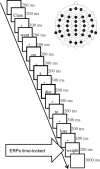Electrophysiological evidence for impaired attentional engagement with phonologically acceptable misspellings in developmental dyslexia
- PMID: 21734903
- PMCID: PMC3124829
- DOI: 10.3389/fpsyg.2011.00139
Electrophysiological evidence for impaired attentional engagement with phonologically acceptable misspellings in developmental dyslexia
Abstract
Event-related potential (ERP) studies of word recognition have provided fundamental insights into the time-course and stages of visual and auditory word form processing in reading. Here, we used ERPs to track the time-course of phonological processing in dyslexic adults and matched controls. Participants engaged in semantic judgments of visually presented high-cloze probability sentences ending either with (a) their best completion word, (b) a homophone of the best completion, (c) a pseudohomophone of the best completion, or (d) an unrelated word, to examine the interplay of phonological and orthographic processing in reading and the stage(s) of processing affected in developmental dyslexia. Early ERP peaks (N1, P2, N2) were modulated in amplitude similarly in the two groups of participants. However, dyslexic readers failed to show the P3a modulation seen in control participants for unexpected homophones and pseudohomophones (i.e., sentence completions that are acceptable phonologically but are misspelt). Furthermore, P3a amplitudes significantly correlated with reaction times in each experimental condition. Our results showed no sign of a deficit in accessing phonological representations during reading, since sentence primes yielded phonological priming effects that did not differ between participant groups in the early phases of processing. On the other hand, we report new evidence for a deficient attentional engagement with orthographically unexpected but phonologically expected words in dyslexia, irrespective of task focus on orthography or phonology. In our view, this result is consistent with deficiency in reading occurring from the point at which attention is oriented to phonological analysis, which may underlie broader difficulties in sublexical decoding.
Keywords: P3a; attention; developmental dyslexia; event-related potential; homophone; orthographic processing; reading.
Figures






Similar articles
-
Phonological, orthographic, and semantic processing during sentence reading in adults with dyslexia: Behavioral and neural correlates.Int J Psychophysiol. 2025 Aug;214:113209. doi: 10.1016/j.ijpsycho.2025.113209. Epub 2025 Jul 4. Int J Psychophysiol. 2025. PMID: 40619103
-
Decoding ability makes waves in reading: deficient interactions between attention and phonological analysis in developmental dyslexia.Neuropsychologia. 2012 Jun;50(7):1553-64. doi: 10.1016/j.neuropsychologia.2012.03.008. Epub 2012 Mar 15. Neuropsychologia. 2012. PMID: 22426204
-
Reading for sound with dyslexia: evidence for early orthographic and late phonological integration deficits.Brain Res. 2011 Apr 18;1385:192-205. doi: 10.1016/j.brainres.2011.02.012. Brain Res. 2011. PMID: 21316349
-
Phonological dyslexia and phonological impairment: an exception to the rule?Neuropsychologia. 2006;44(14):2861-73. doi: 10.1016/j.neuropsychologia.2006.06.006. Epub 2006 Aug 1. Neuropsychologia. 2006. PMID: 16879843 Review.
-
[The reader brain: natural and cultural story].Rev Neurol (Paris). 2008 May;164 Suppl 3:S77-82. doi: 10.1016/S0035-3787(08)73295-8. Rev Neurol (Paris). 2008. PMID: 18675051 Review. French.
Cited by
-
Event-related potential and lexical decision task in dyslexic adults: Lexical and lateralization effects.Front Psychol. 2022 Nov 9;13:852219. doi: 10.3389/fpsyg.2022.852219. eCollection 2022. Front Psychol. 2022. PMID: 36438365 Free PMC article.
-
Typical and Atypical Development of Visual Expertise for Print as Indexed by the Visual Word N1 (N170w): A Systematic Review.Front Neurosci. 2022 Jun 30;16:898800. doi: 10.3389/fnins.2022.898800. eCollection 2022. Front Neurosci. 2022. PMID: 35844207 Free PMC article.
-
Frequency Effects on Spelling Error Recognition: An ERP Study.Front Psychol. 2022 Apr 14;13:834852. doi: 10.3389/fpsyg.2022.834852. eCollection 2022. Front Psychol. 2022. PMID: 35496180 Free PMC article.
References
Grants and funding
LinkOut - more resources
Full Text Sources

